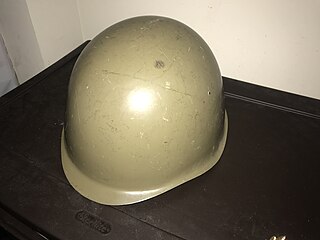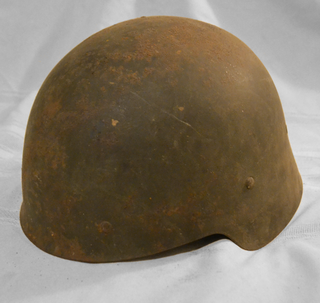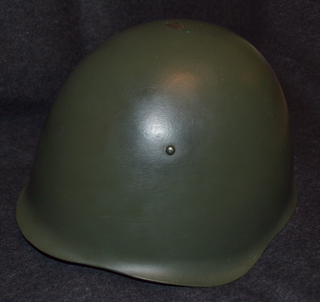
The Brodie helmet is a steel combat helmet designed and patented in London in 1915 by John Leopold Brodie. A modified form of it became the Helmet, Steel, Mark I in Britain and the M1917 Helmet in the U.S. Colloquially, it was called the shrapnel helmet, battle bowler, Tommy helmet, tin hat, and in the United States the doughboy helmet. It was also known as the dishpan hat, tin pan hat, washbasin, battle bowler, and Kelly helmet. The German Army called it the Salatschüssel. The term Brodie is often misused. It is correctly applied only to the original 1915 Brodie's Steel Helmet, War Office Pattern.

The Stahlhelm is a specific type of German military headgear made of steel, which is primarily intended to provide protection against shrapnel and fragments of grenades. The term Stahlhelm refers both to a generic steel helmet, and more specifically to the distinctive German military design.

The M1 helmet is a combat helmet that was used by the U.S. military from World War II until 1985, when it was succeeded by the PASGT helmet. The M1 helmet has become an icon of the US military, with its design inspiring other militaries around the world.

The M15 Adrian helmet was a combat helmet issued to the French Army during World War I. It was the first standard helmet of the French Army and was designed when millions of French troops were engaged in trench warfare, and head wounds from the falling shrapnel generated by indirect fire became a frequent cause of battlefield casualties. Introduced in 1915, it was the first modern steel helmet and it served as the basic helmet of many armies well into the 1930s. Initially issued to infantry soldiers, in modified form they were also issued to cavalry and tank crews. A subsequent version, the M26, was used during World War II.

The hełm wz. 31 was the basic combat helmet of the Polish Army before the outbreak of World War II and during the Invasion of Poland. The helmet became the basic type of combat headgear for Polish military formations in 1930s and during the early stages of World War II. It was also exported to Persia, Albania and Republican Spain. By September 1939 approximately 320,000 copies were delivered to the Polish Army.

The helmet cover was first used by French soldiers during World War I.

The Mk III Helmet was a steel military combat helmet first developed for the British Army in 1941 by the Medical Research Council. First worn in combat by British and Canadian troops on D-Day, the Mk III and Mk IV were used alongside the Brodie helmet for the remainder of the Second World War. It is sometimes referred to as the "turtle" helmet by collectors, because of its vague resemblance to a turtle shell, as well as the 1944 pattern helmet.

The Zuckerman helmet, officially designated the Civilian Protective Helmet, was a British helmet designed for use by civil defence organisations and the general public during World War II. It was researched and designed by Solly Zuckerman, Derman Christopherson and Hugh Cairns.

The Czechoslovakian M53 helmet was used by the Czechoslovak Army from the early 1950s onward. In western European countries and the United States, it is sometimes referred to as the Czech M53 helmet. These helmets are commonly mistaken for, and sometimes marketed as, Soviet SSh-40 helmets, and various other very similar Eastern Bloc helmets.

The M37 helmet is a military steel combat helmet used by Swedish armed forces. Replacing the M1926 helmet, the M1937 would be modernized in 1965 and see use into the 1990s with its replacement by the M1990 Kevlar helmet.

The M32 helmet also known as M32/34 is a military steel combat helmet used by Czechoslovakia from its adoption in 1932 to its annexation by Nazi Germany in 1939. The helmet also being used by the Slovak Republic and Finland among other countries that the helmet would be worn by.

The M1918 helmet is a steel military combat helmet used by Switzerland from its introduction in 1918 to its replacement by the M1971. In 1943 improvements would be made to the design to which it would be called the M1918/40. The helmet would be seen used by Swiss servicemen until the late 20th century.

The M1971 helmet is a military steel combat helmet used by Switzerland from its formal introduction in 1971 until its gradual replacement by the Schuberth B826.

The M1942 helmet is a military steel combat helmet used by Spain from its adoption in 1942 to its replacement by a Spanish M1 copy in the 1980s.

The M1926 Helmet, is a steel combat helmet used by Spain from its adoption in 1930 until its replacement by the M42 in 1942. The helmet would be a common sight along with many other helmets between both sides in the Spanish Civil War.

The M1921 Helmet, is a steel combat helmet developed alongside the M1926 helmet in 1926 for use by the Spanish Army. The model never being formally adopted by the army in favor of the M1926. The exact reasoning for the designation "M1921" is not known as it was developed later.

The M70 is a steel combat helmet used by Hungary, a license made copy of the Soviet SSh-40 and further development of the previous model M50 helmet.

The M1934 helmet is a steel combat helmet used by various factions in the Spanish Civil War. Meant not for use by the Army, but instead by security forces such as police, the helmet was of similar shape to the Model 1926 helmet in use by the army. The helmet would mainly see use by the Nationalists in the conflict.

The Wz50 also known as M50 is a steel combat helmet used by Poland from its introduction in 1950 to its replacement by the Wz67 in 1967. The helmet would be widely exported to a number of Arab countries for its low price.

The M34 is a steel combat helmet used by the Netherlands from its introduction in 1934 replacing the previous M23/27, to the invasion by Nazi Germany in 1940. From which it was replaced by the M53 helmet, a local copy of the American M1 helmet. A tropical variant of this helmet was produced for use by the Dutch East India Army in present-day Indonesia known as the KNIL model.






















